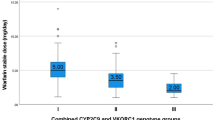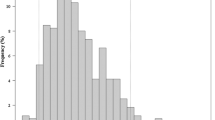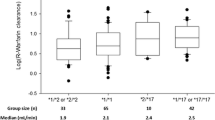Abstract
Background
Initiation of phenprocoumon therapy is associated with a variable individual response. The CYP2C9 genotype has been shown to influence the response to warfarin therapy, but such an effect on phenprocoumon therapy remains uncertain.
Method
Two hundred sixty hospital patients started on phenprocoumon were recruited for this study. Body mass index (BMI), waist and hip circumference, dietary habits, comorbidity, and comedication were initially assessed. A 5′ exonuclease assay (TaqManR) was used to analyze the presence of five polymorphisms of the CYP2C9 gene in each of the study patients. Study endpoints included the time necessary to achieve the international normalized ratio (INR) target (INR >2) and the total drug amount required to attain target INR. For 250 of 260 patients, the subsequent required daily maintenance dose of phenprocoumon was also recorded.
Results
Both the necessary time and total dose required to attain target INR correlated significantly with BMI. The leaner the patient, the shorter the required time interval [BMI <22 (n=31), 5.48±2.49 days; BMI 22–25 (n=70), 6.09±2.40; BMI 25–30 (n=113), 6.76±3.61; BMI >30 (n=46), 8.50±5.75; p=0.001] and the lower the required dosage until the therapeutic range was achieved [BMI <22 (n=31), 23.8±12.1 mg; BMI 22–25 (n=70), 25.9±11.4 mg; BMI 25–30 (n=113), 29.6±25.2; BMI >30 (n=46), 35.8±19.7; p=0.027]. Overweight and waist circumference as a surrogate marker for abdominal fat were also associated significantly with these two parameters. Moreover, obesity was associated with a lower body-weight-adjusted maintenance dosage. All CYP2C9 genotypes that were tested failed to reveal an association with individual response variability.
Conclusion
Patient obesity appears to directly correspond to the amount of phenprocoumon required during initiation of therapy. The CYP2C9 genotype was not shown to influence the necessary therapeutic dosage.

Similar content being viewed by others
References
Aithal GP, Day CP, Kesteven PJ, Daly AK (1999) Association of polymorphisms in the cytochrome P450 CYP2C9 with warfarin dose requirement and risk of bleeding complications. Lancet 353(9154):717–719
Cannegieter SC, Torn M, Rosendaal FR (1999) Oral anticoagulant treatment in patients with mechanical heart valves: how to reduce the risk of thromboembolic and bleeding complications. J Intern Med 245(4):369–374
Fihn SD, Gadisseur AA, Pasterkamp E, van der Meer FJ, Breukink-Engbers WG, Geven-Boere LM, van Meegen E, de Vries-Goldschmeding H, Antheunissen-Anneveld I, van’t Hoff AR, Harderman D, Smink M, Rosendaal FR (2003) Comparison of control and stability of oral anticoagulant therapy using acenocoumarol versus phenprocoumon. Thromb Haemost 90(2):260–266
Harder S, Thurmann P (1996) Clinically important drug interactions with anticoagulants. An update. Clin Pharmacokinet 30(6):416–444
He M, Korzekwa KR, Jones JP, Rettie AE, Trager WF (1999) Structural forms of phenprocoumon and warfarin that are metabolized at the active site of CYP2C9. Arch Biochem Biophys 372(1):16–28
Heaf J, Guldager B (1990) Algorithm for short-term prescription of phenprocoumon. Haemostasis 20(1):21–30
Higashi MK, Veenstra DL, Kondo LM, Wittkowsky AK, Srinouanprachanh SL, Farin FM, Rettie AE (2002) Association between CYP2C9 genetic variants and anticoagulation-related outcomes during warfarin therapy. JAMA 287(13):1690–1698
Hummers-Pradier E, Hess S, Adham IM, Papke T, Pieske B, Kochen MM (2003) Determination of bleeding risk using genetic markers in patients taking phenprocoumon. Eur J Clin Pharmacol 59(3):213–219
Kamali F, Khan TI, King BP, Frearson R, Kesteven P, Wood P, Daly AK, Wynne H (2004) Contribution of age, body size, and CYP2C9 genotype to anticoagulant response to warfarin. Clin Pharmacol Ther 75(3):204–212
Kirchheiner J, Ufer M, Walter EC, Kammerer B, Kahlich R, Meisel C, Schwab M, Gleiter CH, Rane A, Roots I, Brockmoller J (2004) Effects of CYP2C9 polymorphisms on the pharmacokinetics of R-and S-phenprocoumon in healthy volunteers. Pharmacogenetics 14(1):19–26
Penning-van Beest FJ, Rosendaal FR, Grobbee DE, van Meegen E, Stricker BH (1999) Course of the international normalized ratio in response to oral vitamin K1 in patients overanticoagulated with phenprocoumon. Br J Haematol 104(2):241–245
Russmann S, Gohlke-Barwolf C, Jahnchen E, Trenk D, Roskamm H (1997) Age-dependent differences in the anticoagulant effect of phenprocoumon in patients after heart valve surgery. Eur J Clin Pharmacol 52(1):31–35
Schalekamp T, Oosterhof M, van Meegen E, van Der Meer FJ, Conemans J, Hermans M, Meijerman I, de Boer A (2004) Effects of cytochrome P450 2C9 polymorphisms on phenprocoumon anticoagulation status. Clin Pharmacol Ther 76(5):409–417
Trenk D, Althen H, Jahnchen E, Meinertz T, Oie S (1987) Factors responsible for interindividual differences in the dose requirement of phenprocoumon. Eur J Clin Pharmacol 33(1):49–54
Ufer M, Kammerer B, Kahlich R, Kirchheiner J, Yasar U, Brockmoller J, Rane A (2004) Genetic polymorphisms of cytochrome P450 2C9 causing reduced phenprocoumon (S)-7-hydroxylation in vitro and in vivo. Xenobiotica 34(9):847–859
Ufer M, Svensson JO, Krausz KW, Gelboin HV, Rane A, Tybring G (2004) Identification of cytochromes P450 2C9 and 3A4 as the major catalysts of phenprocoumon hydroxylation in vitro. Eur J Clin Pharmacol 60(3):173–182
van Haeften TW, de Vries J, Sixma JJ (1997) Concordance of phenprocoumon dosage in married couples. BMJ 314(7091):1386
Visser LE, van Schaik RH, van Vliet M, Trienekens PH, De Smet PA, Vulto AG, Hofman A, van Duijn CM, Stricker BH (2004) The risk of bleeding complications in patients with cytochrome P450 CYP2C9*2 or CYP2C9*3 alleles on acenocoumarol or phenprocoumon. Thromb Haemost 92(1):61–66
Visser LE, van Vliet M, van Schaik RH, Kasbergen AA, De Smet PA, Vulto AG, Hofman A, van Duijn CM, Stricker BH (2004) The risk of overanticoagulation in patients with cytochrome P450 CYP2C9*2 or CYP2C9*3 alleles on acenocoumarol or phenprocoumon. Pharmacogenetics 14(1):27–33
Wilkerson WR, Sane DC (2002) Aging and thrombosis. Semin Thromb Hemost 28(6):555–568
Acknowledgements
This study was supported by the START program of the University Hospital of Aachen and is part of the doctoral thesis of C. Meyer zu Schwabedissen.
Author information
Authors and Affiliations
Corresponding author
Rights and permissions
About this article
Cite this article
Schwabedissen, C.M.z., Mevissen, V., Schmitz, F. et al. Obesity is associated with a slower response to initial phenprocoumon therapy whereas CYP2C9 genotypes are not. Eur J Clin Pharmacol 62, 713–720 (2006). https://doi.org/10.1007/s00228-006-0158-3
Received:
Accepted:
Published:
Issue Date:
DOI: https://doi.org/10.1007/s00228-006-0158-3




